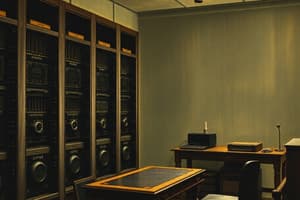Podcast
Questions and Answers
Which type of scanner is specifically designed to convert images into digital format?
Which type of scanner is specifically designed to convert images into digital format?
- Document Scanner
- Photo Scanner (correct)
- Drum Scanner
- Flatbed Scanner
Which type of touchscreen technology uses a surface coated with a resistive layer that registers touch?
Which type of touchscreen technology uses a surface coated with a resistive layer that registers touch?
- Projected Capacitive Touchscreen
- Resistive Touchscreen (correct)
- Optical Touchscreen
- Capacitive Touchscreen
In the context of audio input, which microphone type is most commonly used for recording in professional settings due to its sound quality?
In the context of audio input, which microphone type is most commonly used for recording in professional settings due to its sound quality?
- Lavalier Microphone
- Condenser Microphone (correct)
- Boundary Microphone
- Dynamic Microphone
Which type of input device is characterized by a ball that rotates on the surface beneath it to detect movement?
Which type of input device is characterized by a ball that rotates on the surface beneath it to detect movement?
Which category of devices includes components that provide visual output to users?
Which category of devices includes components that provide visual output to users?
What innovation did Lee De Forest contribute to the development of electronic computers?
What innovation did Lee De Forest contribute to the development of electronic computers?
What was the primary purpose of the ENIAC computer when it was first designed?
What was the primary purpose of the ENIAC computer when it was first designed?
Which invention replaced the vacuum tube and was key to revolutionizing computer technology?
Which invention replaced the vacuum tube and was key to revolutionizing computer technology?
Who were the pioneers behind the development of integrated circuits during the 1960s?
Who were the pioneers behind the development of integrated circuits during the 1960s?
What significant change did the introduction of personal computers in the 1970s bring about?
What significant change did the introduction of personal computers in the 1970s bring about?
Flashcards are hidden until you start studying
Study Notes
Historical Developments in Computing
- Vacuum Tubes (1904): Lee De Forest invented vacuum tubes, essential for amplifying and controlling electrical signals, leading to electronic computers.
- ENIAC (1946): One of the first general-purpose electronic computers, designed for complex calculations primarily for scientific and military applications.
- Transistor (1947): Invented by John Bardeen, Walter Brattain, and William Shockley, transistors replaced vacuum tubes, significantly advancing computer technology by reducing size and improving reliability.
- Integrated Circuits (1960s): Developed by Jack Kilby and Robert Noyce, integrated circuits allowed for miniaturization, enabling more powerful computers in a compact form factor.
- Personal Computers (1970s): Introduction of PCs like the Altair 8800 and Apple II expanded computing access, leading to a revolution in personal computing.
- Graphical User Interface (1980s): GUIs, popularized by Apple Macintosh and Microsoft Windows, made computers more user-friendly and widely accessible.
Input Devices
- Touchscreens: Allow users to input commands by touching the display; include various types like resistive, capacitive, and infrared.
- Scanners: Convert physical documents to digital formats; types include flatbed, sheet-fed, and portable scanners.
- Microphones: Capture audio input for voice commands or recordings; types include USB, condenser, and lavalier microphones.
Output Devices
- Monitors: Display visual output such as text and graphics; available types include LCD, LED, OLED, and gaming monitors.
- Printers: Produce hard copies; types vary from inkjet and laser to 3D and multifunction printers.
- Speakers: Output sound for audio playback; options include bookshelf, tower, soundbar, and Bluetooth speakers.
- Projectors: Display images on larger screens; types include LCD, DLP, LED, and laser projectors.
System Unit Components
- Motherboard: The main circuit board connecting all internal components; various form factors include ATX, Micro-ATX, and Mini ITX.
- Central Processing Unit (CPU): The brain of the computer handling instructions and calculations; variations include desktop, mobile, server, and gaming CPUs.
- Random Access Memory (RAM): Temporary storage for data and program instructions; includes types like DRAM and DDR SDRAM.
- Power Supply: Provides electrical power to system components; available types include ATX, SFX, and modular supplies.
Storage Devices
- Hard Disk Drives (HDDs): High-capacity storage devices for data and programs; classifications include internal, external, and surveillance HDDs.
- Solid-State Drives (SSDs): Faster and more reliable than HDDs; types include SATA, NVMe, M.2, and PCIe SSDs.
- USB Flash Drives: Portable storage for data transfer; varieties include standard, high-speed, and secure USB drives.
- Optical Disc Drives: Read/write data to optical media such as CDs and DVDs; includes CD-ROM and Blu-Ray drives.
Computing Power Characteristics
- Processing Speed: Computers can execute millions to billions of calculations per second, resulting in rapid data processing and complex computations.
- Memory Capacity: Ability to store vast amounts of data, accommodating various file types including text, images, and videos.
- Parallel Processing: Improves overall performance by dividing tasks into smaller subtasks that can be processed simultaneously.
Types of Computers
- Embedded Computers: Integrated into other devices like appliances and medical equipment; examples include car control systems and smart home devices.
- Workstations: High-performance machines optimized for tasks like graphic design and scientific modeling; examples include HP Z Series and Dell Precision workstations.
Evolution of Computing Eras
- Computer Age: Emerged in the mid-20th century; significant advancements included transistors, microprocessors, and the World Wide Web, revolutionizing data processing and storage.
- Information Age: Followed the Computer Age, characterized by the rapid expansion of information technology, internet rise, and mobile devices enabling global communication and data access.
- Digital Age: Represents the present era where digital technologies are interconnected, with advancements in artificial intelligence, big data, cloud computing, and the Internet of Things driving innovation.
Studying That Suits You
Use AI to generate personalized quizzes and flashcards to suit your learning preferences.




